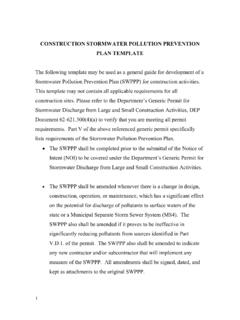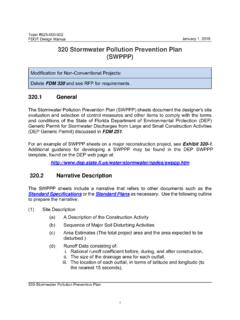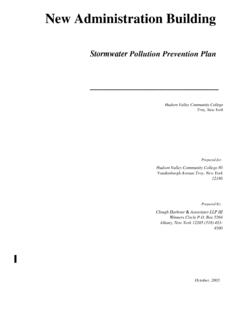Transcription of Developing Your Stormwater Pollution Prevention Plan: A ...
1 Developing your Stormwater Pollution Prevention plan : A Guide for Industrial Operators iContentsSection 1: Introduction ..11 .A Why Should You Use This Guide? ..11 .B What Is Stormwater Runoff and What Are Its Impacts? ..1 Section 2: Getting Started ..32 .A Am I Required to Develop a SWPPP? ..32 .B What Are the Basic Elements Required in a SWPPP? ..42 .C Stormwater Pollution Prevention Team (Step 1) ..52 .D What Do I Need to Do to Complete My SWPPP? ..6 Section 3: Site Assessment and Planning (Step 2) ..73 .A Conduct an Assessment of the Activities Performed at your Facility ..73 .B Evaluate Sampling Data ..3 .C Develop General Location and Site Maps ..Section 4: Selecting Control Measures (Step 3) ..144 .A Minimize Exposure ..154 .B Good Housekeeping ..174 .C Maintenance ..184 .D Spill Prevention and Response Procedures.
2 184 .E Erosion and Sediment Controls ..194 .F Management of Runoff ..204 .G Salt Storage Piles or Piles Containing Salt ..204 .H Sector-Specific Requirements ..214 .I Employee Training ..224 .J Non- Stormwater Discharges ..234 .K Waste, Garbage, and Floatable Debris ..234 .L Dust Generation and Vehicle Tracking of Industrial Materials ..244 .M Numeric Effluent Limitations Based on Effluent Limit Guidelines ..244 .N Additional Controls to Address Impaired Waters ..25 Section 5: Procedures for Inspections and Monitoring (Step 4) ..265 .A Routine Facility Inspections ..265 .B Visual Assessments ..295 .C Annual Comprehensive Site Inspections ..315 .D Documentation of Monitoring Procedures ..331011 ii Developing your Stormwater Pollution Prevention plan : A Guide for Industrial OperatorsSection 6: Completing your SWPPP.
3 346 .A Finish your SWPPP ..346 .B Obtain NPDES Permit Coverage ..346 .C Updating your SWPPP ..35 Section 7: Keeping Records of your Implementation Activities ..36 Section 8: Common Compliance Problems at Industrial Facilities ..37 Resources ..39 AppendicesAppendix A: MSGP SWPPP Template ..40 Appendix B: Additional MSGP Documentation Template ..41 Appendix C: Example Site Map ..42 Developing your Stormwater Pollution Prevention plan : A Guide for Industrial Operators 1 Section 1: IntroductionThis guide includes suggestions on how to develop a Stormwater Pollution Prevention plan (SWPPP) . This guide does not impose any new legally binding requirements on EPA, States, or the regulated community, and does not confer legal rights or impose legal obligations upon any member of the public . In the event of a conflict between the discussion in this document and any statute, regulation, or permit, this document would not be controlling.
4 Interested parties are free to raise questions and objections about the substance of this guide and the appropriateness of the application of this guide to a particular situ-ation . EPA and other decision makers retain the discretion to adopt approaches on a case-by-case basis that differ from those described in this guide where appropriate . Why Should You Use This Guide?You should use this guide if you are an operator of an industrial facility required to develop a Stormwater Pollution Prevention plan (SWPPP) that complies with a National Pollutant Discharge Elimination System (NPDES) industrial Stormwater permit issued by your State or the U .S . Environmental Protection Agency (EPA) . You may also find this guide to be useful if you are a State or EPA inspector who reviews SWPPPs, or you operate a commercial facility that is not required to obtain an NPDES permit but you are nevertheless interested in ways to minimize Stormwater -related Pollution at your facility.
5 Because each State permit can be slightly different, this guide is written more generi-cally in an attempt to make it applicable to as many industrial general permits as possible . Owners and operators of industrial facilities should carefully read their respective industrial Stormwater general permit to understand where using this guide may conflict with a State SWPPP require-ment, and make adjustments to their SWPPPs as needed . EPA includes additional text describing how to address SWPPP requirements that are specifically included in the Agency s own 2008 Multi-Sector General Permit (MSGP), the 2008 MSGP .In addition to helping you develop a SWPPP, this guide also includes sections that will assist you in keeping your implemen-tation records and in avoiding common compliance problems, after you are authorized under the EPA 2008 MSGP or your State s general permit.
6 See Section 7 for a discussion of how to keep implementation records . See Section 8 for a discussion of common compliance problems . What Is Stormwater Runoff and What Are Its Impacts? Stormwater runoff is water from rain or snowmelt that does not immediately infiltrate into the ground and flows over or through natural or man-made storage or convey-ance systems . When undeveloped areas are converted to land uses with impervious surfaces such as buildings, parking lots, and roads, the natural hydrology of the land is altered and can result in increased surface runoff rates, volumes, and pollut-ant loads . Stormwater runoff picks up industrial pollutants and typically discharges them directly into nearby waterbodies or indirectly via storm sewer systems . Runoff from areas where industrial activities occur can contain toxic pollutants (e.)
7 G ., heavy Owners and operators of industrial facilities, which are subject to a State or EPA industrial Stormwater general permit typically must develop a SWPPP as a basic requirement. If your facility is subject to such a requirement, failing to develop a SWPPP can result in enforcement action against your facility by EPA or a State! For example, EPA has targeted enforcement actions against some industrial sectors for failing to have developed SWPPPs for their Developing your Stormwater Pollution Prevention plan : A Guide for Industrial Operatorsmetals and organic chemicals) and other pollutants such as trash, debris, and oil and grease, when facility practices allow exposure of industrial materials to Stormwater . This increased flow and pollutant load can impair waterbodies, degrade biological habitats, pol-lute drinking water sources, and cause flood-ing and hydrologic changes to the receiving water, such as channel erosion.
8 Industrial facilities typically perform a portion of their activities in outdoor areas exposed to the elements . This may include activities such as material storage and han-dling, vehicle fueling and maintenance, ship-ping and receiving, and salt storage, all of which can result in pollutants being exposed to precipitation and capable of being carried off in Stormwater runoff . Also, facilities may have performed industrial activities outdoors in the past and materials from those activities still remain exposed to precipitation . In addi-tion, accidental spills and leaks, improper waste disposal, and illicit connections to storm sewers may also lead to exposure of pollutants to Stormwater .EPA has identified six types of activities at industrial facilities that have the potential to be major sources of pollutants in Stormwater : Loading and Unloading OperationsLoading and unloading operations can include pumping of liquids or gases from tankers to storage facilities, pneumatic transfer of dry chemicals, transfer by mechanical conveyor systems, or transfer of bags, boxes, drums or other contain-ers by forklift or other material handling equipment.
9 Material spills or losses in these areas can accumulate and be washed away during a storm . Outdoor StorageOutdoor storage activities include stor-age of fuels, raw materials, by-products, intermediate products, final products, and process residuals . Materials may be stored in containers, on platforms or pads, in bins, boxes or silos, or as piles . Storage areas that are exposed to rainfall and/or runoff can contribute pollutants to Stormwater when solid materials wash off or materials dissolve into solution . Outdoor Process ActivitiesAlthough many manufacturing activities are performed indoors, some activities, such as timber processing, rock crush-ing, and concrete mixing, occur outdoors . Outdoor processing activities can result in liquid spillage and losses of material solids, which makes associated pollutants avail-able for discharge in runoff.
10 Dust or Particulate Generating ProcessesDust or particulate generating processes include industrial activities with stack emissions or process dusts that settle on surfaces . Some industries, such as mines, cement manufacturing, and refractories, also generate significant levels of dust that can be mobilized in Stormwater runoff . Illicit Connections and Non- Stormwater DischargesIllicit connections of process wastes or other pollutants to Stormwater collection systems, instead of to sanitary sewers, can be a significant source of Stormwater pol-lution . Non- Stormwater discharges include any discharge from the facility that is not generated by rainfall runoff (for example, wash water from industrial processes) . With few exceptions, these non- Stormwater discharges are prohibited . Refer to your permit for a list of authorized non-storm-water discharges.



















